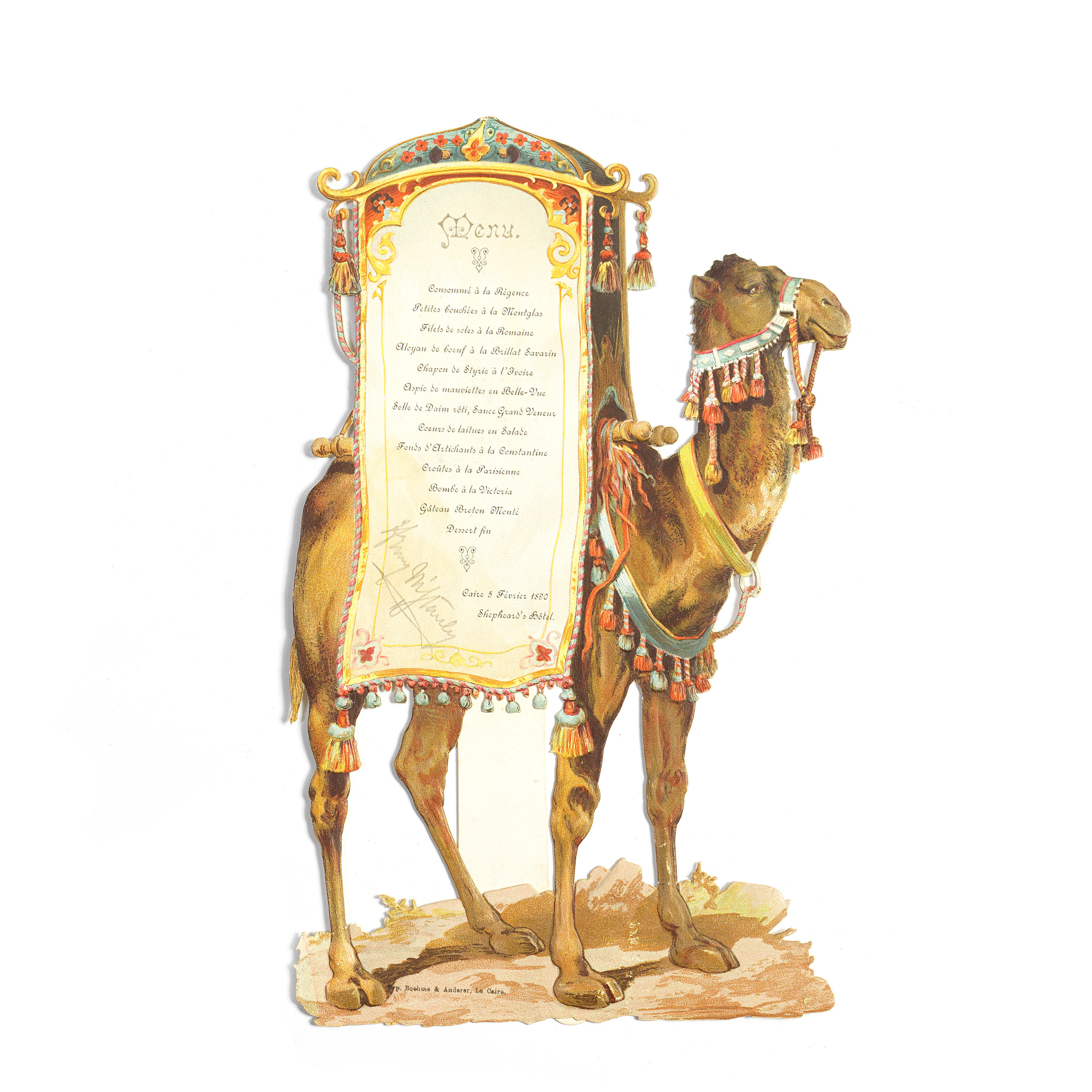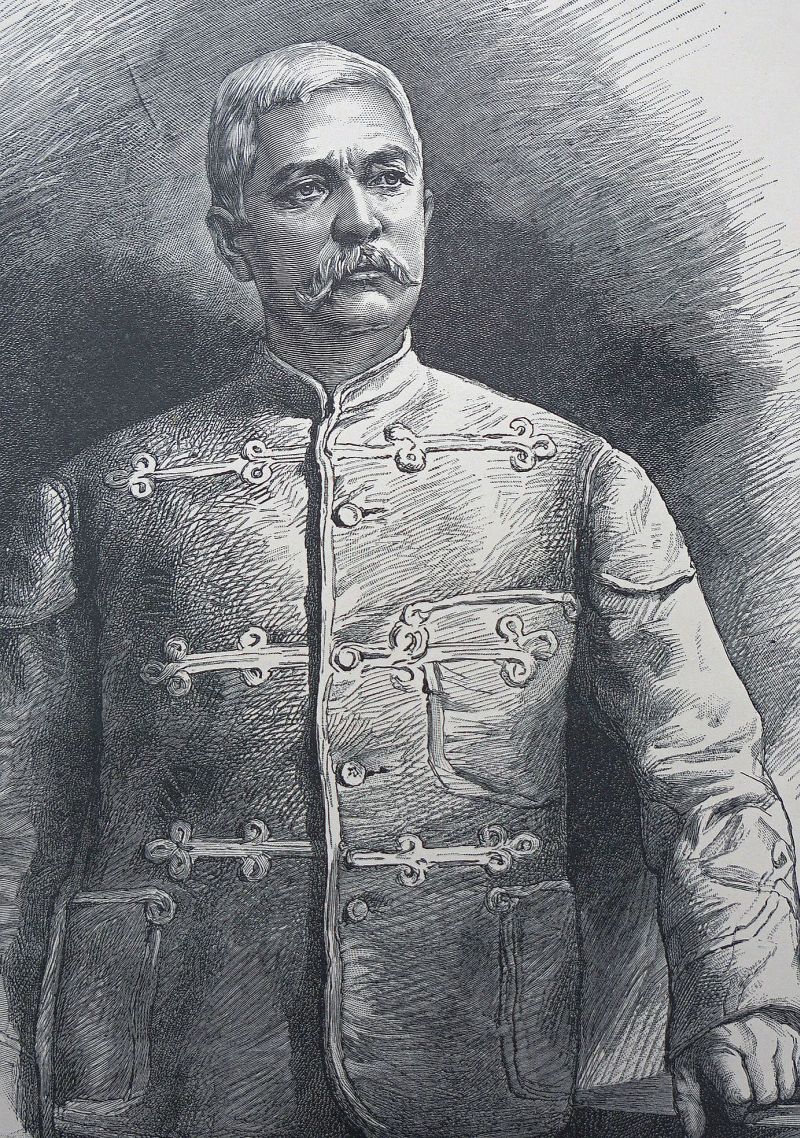STANLEY, Henry M. (1841-1904). Out West During Two Indian Campaigns. N.p.: Printed for Private Circulation [by Hazell, Watson & Viney, Ltd., London & Aylesbury], [ca 1891].
STANLEY, Henry M. (1841-1904). Out West During Two Indian Campaigns. N.p.: Printed for Private Circulation [by Hazell, Watson & Viney, Ltd., London & Aylesbury], [ca 1891]. 2 o (310 x 248 mm). Modern, gray cloth boards, original wrappers reinforced with mylar (some text offset on upper wrapper). AN UNRECORDED WORK: HENRY M. STANLEY AS WITNESS TO THE INDIAN CAMPAIGNS OF 1867. Born in Wales in 1841, Stanley traveled to New Orleans in 1859, remained in the United States and served the Confederacy during the Civil War. After the war he became a freelance journalist. In 1866 George Ward Nichols interviewed Wild Bill Hickok about his exploits as a gunfighter. The article appeared in the February 1867 edition of Harper's New Monthly Magazine. Newspapers such as the Leavenworth Daily Conservative, Kansas Daily Commonwealth, Springfield Patriot and the Atchison Daily Champion quickly noted that the article was full of inaccuracies and that Hickok was lying when he claimed he had killed "hundreds of men." Hickok responded to these articles by giving an interview to Henry M. Stanley. The article appeared in the St. Louis Missouri Democrat in April 1867. The present text collects Stanley's dispatches from the West, including his 4 April report from Fort Harker, Kansas where he met with Hickok. It included the following dialogue: "'I say, Bill, or Mr. Hickok, how many white men have you killed to your certain knowledge?' After a little deliberation, he replied, 'I would be willing to take my oath on the Bible to-morrow that I have killed over a hundred, a long ways off.' 'What made you kill all those men? Did you kill them without cause or provocation?' 'No, by heaven! I never killed one man without good cause'" (p. 2). Stanley profiles Hickok's men, Jack Harvey and Tom Atkins. Forty-two further reports follow this encounter with Hickok, posted in Kansas from Fort Zarah, Fort Larned (including a "Sketch of an Officer's Life on the Frontier"), a Cheyenne Camp outside Fort Larned, Fort Dodge, Fort Hayes ("The Last and most important Pow-Wow," 3 May where Satanta appeared in person and where Colonel Jesse H. Leavenworth, Indian agent, was then "a cripple, and almost a paralytic"), Junction City ("this city is destined to become an important one in the west," 11 May). At the end of May, Stanley was in present-day Nebraska, reporting on his trip up the Missouri to Omaha, with the Indian war "at last been fairly opened" on 25 May. The same post gives details about train travel from Omaha to Denver on the Union Pacific. Stanley eventually travels to Fort Kearney, North Platte, to the end of the Union Pacific Track 370 miles west of Omaha where a serious battle was waged and to Fort Laramie. By June he was in Colorado, though briefly before returning to Omaha where he posted reports of the Plum Creek Massacre. His post on 20 September from North Platte records General Sherman's speech and the response of the Sioux "Big Mouth." The final posts describe the treaty proposed by Senator Henderson and its favorable reception by the Kiowas and Comanches, and its signing on 21 October. Hostilities from other tribes followed, and a general policy was established "to concentrate the troops along the great highways of travel." AN EXTREMELY RARE TITLE: this publication of Stanley's columns for the St. Louis Missouri Democrat is not traced in the British Museum General Catalogue or the RLG Union Catalog. Furthermore, it is not recorded in Casada's bibliography, nor in Laniger-Goumaz's and Helling's Henry Morton Stanley Bibliographie. It is possible that he collected copies of the Missouri Democrat in 1890, while touring the United States, with the intention of publishing his old stories. His 2-volume memoir was published in 1895. Only one other copy has sold at auction in the last 30 years, Christie's, New York, 21 June 2005, lot 333, $26,000.
STANLEY, Henry M. (1841-1904). Out West During Two Indian Campaigns. N.p.: Printed for Private Circulation [by Hazell, Watson & Viney, Ltd., London & Aylesbury], [ca 1891].
STANLEY, Henry M. (1841-1904). Out West During Two Indian Campaigns. N.p.: Printed for Private Circulation [by Hazell, Watson & Viney, Ltd., London & Aylesbury], [ca 1891]. 2 o (310 x 248 mm). Modern, gray cloth boards, original wrappers reinforced with mylar (some text offset on upper wrapper). AN UNRECORDED WORK: HENRY M. STANLEY AS WITNESS TO THE INDIAN CAMPAIGNS OF 1867. Born in Wales in 1841, Stanley traveled to New Orleans in 1859, remained in the United States and served the Confederacy during the Civil War. After the war he became a freelance journalist. In 1866 George Ward Nichols interviewed Wild Bill Hickok about his exploits as a gunfighter. The article appeared in the February 1867 edition of Harper's New Monthly Magazine. Newspapers such as the Leavenworth Daily Conservative, Kansas Daily Commonwealth, Springfield Patriot and the Atchison Daily Champion quickly noted that the article was full of inaccuracies and that Hickok was lying when he claimed he had killed "hundreds of men." Hickok responded to these articles by giving an interview to Henry M. Stanley. The article appeared in the St. Louis Missouri Democrat in April 1867. The present text collects Stanley's dispatches from the West, including his 4 April report from Fort Harker, Kansas where he met with Hickok. It included the following dialogue: "'I say, Bill, or Mr. Hickok, how many white men have you killed to your certain knowledge?' After a little deliberation, he replied, 'I would be willing to take my oath on the Bible to-morrow that I have killed over a hundred, a long ways off.' 'What made you kill all those men? Did you kill them without cause or provocation?' 'No, by heaven! I never killed one man without good cause'" (p. 2). Stanley profiles Hickok's men, Jack Harvey and Tom Atkins. Forty-two further reports follow this encounter with Hickok, posted in Kansas from Fort Zarah, Fort Larned (including a "Sketch of an Officer's Life on the Frontier"), a Cheyenne Camp outside Fort Larned, Fort Dodge, Fort Hayes ("The Last and most important Pow-Wow," 3 May where Satanta appeared in person and where Colonel Jesse H. Leavenworth, Indian agent, was then "a cripple, and almost a paralytic"), Junction City ("this city is destined to become an important one in the west," 11 May). At the end of May, Stanley was in present-day Nebraska, reporting on his trip up the Missouri to Omaha, with the Indian war "at last been fairly opened" on 25 May. The same post gives details about train travel from Omaha to Denver on the Union Pacific. Stanley eventually travels to Fort Kearney, North Platte, to the end of the Union Pacific Track 370 miles west of Omaha where a serious battle was waged and to Fort Laramie. By June he was in Colorado, though briefly before returning to Omaha where he posted reports of the Plum Creek Massacre. His post on 20 September from North Platte records General Sherman's speech and the response of the Sioux "Big Mouth." The final posts describe the treaty proposed by Senator Henderson and its favorable reception by the Kiowas and Comanches, and its signing on 21 October. Hostilities from other tribes followed, and a general policy was established "to concentrate the troops along the great highways of travel." AN EXTREMELY RARE TITLE: this publication of Stanley's columns for the St. Louis Missouri Democrat is not traced in the British Museum General Catalogue or the RLG Union Catalog. Furthermore, it is not recorded in Casada's bibliography, nor in Laniger-Goumaz's and Helling's Henry Morton Stanley Bibliographie. It is possible that he collected copies of the Missouri Democrat in 1890, while touring the United States, with the intention of publishing his old stories. His 2-volume memoir was published in 1895. Only one other copy has sold at auction in the last 30 years, Christie's, New York, 21 June 2005, lot 333, $26,000.















Testen Sie LotSearch und seine Premium-Features 7 Tage - ohne Kosten!
Lassen Sie sich automatisch über neue Objekte in kommenden Auktionen benachrichtigen.
Suchauftrag anlegen